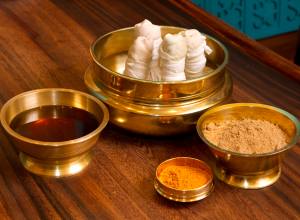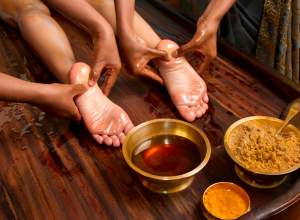
Ayurveda
Ayurveda is an ancient form of alternative/complimentary medicine that stems from the Vedic culture of India. Over 5,000 years old, the practice focuses on balancing three elemental substances in the body (doshas called Vata, Pitta and Kapha) for optimal health. Both Tibetan medicine and Traditional Chinese Medicine are thought to have their roots in Ayurveda.
Translated as “life knowledge,” Ayurveda is thought of as more than a form of medicine. It’s actually a form of science that claims health is a balance of the mind, body and spirit in our individual environment. Ayurveda uses aromatherapy, herbs, diet, massage and meditation to achieve balance of the three doshas.
Dosha Balance
According to The Chopra Center, each human has a unique proportion of doshas in their system and for each element, there is a balanced and imbalance expression: “When Vata is balanced, a person is lively and creative, but when there is too much movement in the system, a person tends to experience anxiety, insomnia, dry skin, constipation, and difficulty focusing. When Pitta is functioning in a balanced manner, a person is warm, friendly, disciplined, a good leader, and a good speaker. When Pitta is out of balance, a person tends to be compulsive and irritable and may suffer from indigestion or an inflammatory condition. When Kapha is balanced, a person is sweet, supportive, and stable but when Kapha is out of balance, a person may experience sluggishness, weight gain, and sinus congestion.”
Ayurveda Components and Terminology
There are eight components of Ayurveda. They are Kayachikitsa (general medicine), Shalya tantra (surgical techniques), Śālākya-tantra (ophthalmology), Kaumāra-bhṛtya Bhuta-vidya (micro-organisms), Agada-tantra (antidotes to poison), Rasayana-tantra (geriatrics/anti-aging), Vajikarana tantra (aphrodisiacs) and Bala Roga (treamtment of children).
Ayurveda names seven tissues. They include plasma (rasa), blood (rakta), muscles (māmsa), fat (meda), bone (asthi), marrow (majja), and semen (shukra).
Ayurvedic Massage
Ayurvedic massage (also called Padabhyanga) is a fundamental part of Ayurveda. Massage techniques and aromatic oils are used to unblock body channels (called srotas) that transport fluids. Blocked or unhealthy channels are thought to cause illness and disease.
Daily ayurvedic foot rubs have the ability to:
- Maintain hearing and eyesight
- Relax the body’s physiology
- Boost revitalization
- Alleviate foot pain
- Decrease insomnia
- Reduce stress
- Nourish the skin
- Improve foot and leg muscle tone
- Boost immunity
- Help with digestion
- Balance emotions
- Prevent bacterial and fungal infections
Health Conditions Ayurveda Can Help
Ayurveda has the ability to ease and/or cure many health concerns. A few include abscesses, anxiety, cough, depression, fever, diarrhea, dropsy, insomnia, seizures, sprains, stress, tumors, leprosy, anal fistulas, fractures, angina pectoris, diabetes, hypertension, heart disease, stones and general foot pain.
Health Warnings
While many aspects of Ayurveda are considered safe, controversy arose in the mid-2000s when 20% of Ayurvedic U.S. and Indian-manufactured medicines sold online were found to contain toxic levels of heavy metals including arsenic, mercury and lead. The U.S. Centers for Disease Control and Prevention (CDC) linked Ayurvedic drugs to lead poisoning in 2012. Currently, the U.S. Food and Drug Administration (FDA) has an import alert on Ayurvedic products from outside countries.
Notice concerning medical entries:
Articles having medical content shall serve exclusively for the purpose of general information. Such articles are not suitable for any (self-) diagnosis and treatment of individual illnesses and medical indications. In particular, they cannot substitute for the examination, advice, or treatment by a licensed physician or pharmacist. No replies to any individual questions shall be effected through the articles.








